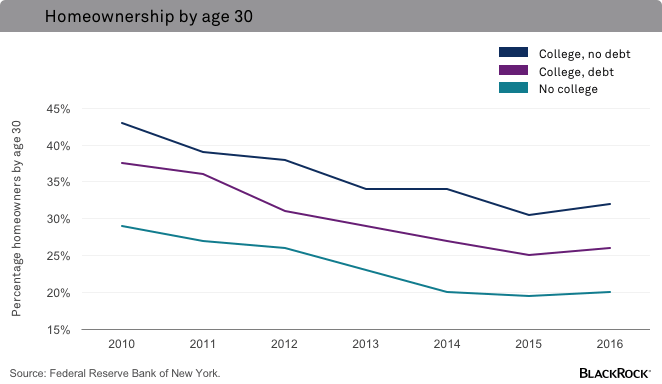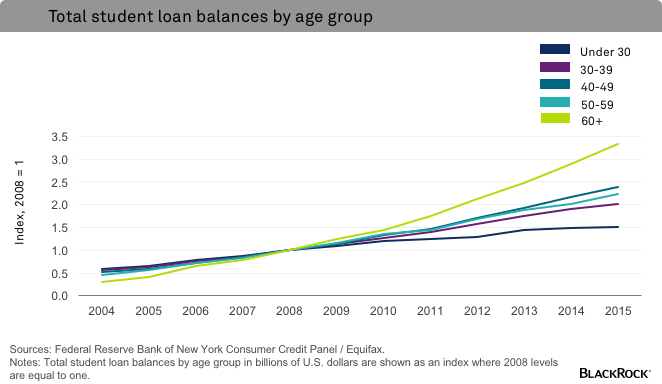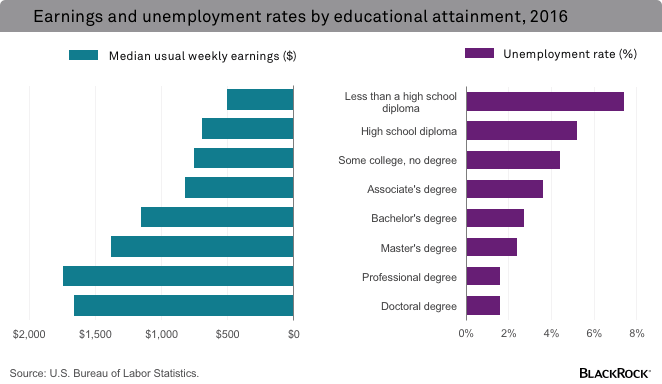The student loan crisis's drag on the economy in 3 charts

This article initially appeared on the BlackRock blog.
It’s no secret that we’re in the midst of a student loan crisis. Student loan debt has grown more than auto loan, credit card and home equity loan debt combined since 2003, according to the Federal Reserve Bank of New York, as the cost of higher education has skyrocketed and more students have flocked to get degrees.
The proliferation of high-interest student loans has outpaced inflation and earnings growth for college graduates, and delinquency rates for student loans are now higher than those for credit cards, auto loans, home equity loans and mortgages, Federal Reserve Bank of New York data show.
What doesn’t get mentioned as much, however, is that today’s student loan crisis isn’t just a negative for graduates struggling to pay off debts. Rather, it also has under-appreciated negative side effects for the U.S. economy as a whole.
It represents a headwind to U.S. economic growth and may also worsen the class divide. When faced with today’s high college costs coupled with the prospect of taking on significant debt, more students from lower-income households will likely choose not to attend college. This, in turn, may make it harder for them to attain the skills required for thriving in a mature, service-oriented and technology-driven U.S. economy.
The three charts below show how the crisis is likely to be a major drag on the U.S. economy for years to come if it remains unaddressed by fiscal policy, potentially providing fuel to superficial arguments for why the U.S. economy doesn’t appear to be performing as well as it could be. Such arguments will potentially cite factors such as a productivity deficiency, rather than the real underlying dynamics like rising student loan debt.
The home ownership rate in the U.S. has fallen each year over the last six years, according to the U.S. Census Bureau. This is despite a solid economic recovery. Our take on what’s behind the declining home ownership rate: Student loans are making it harder for first-time home buyers to buy homes.
Those struggling to pay off loans often lack the savings to make down payments and have lower credit scores than those with no student loan debt, and it’s unlikely mortgage lenders would want to have them as customers. More than 70% of would-be first-time home buyers said student loan debt is delaying their home purchase, according to a National Association of Realtors survey. Indeed, home ownership levels by age 30 are much lower among those with college debt than those without, and they’ve generally been on a downward trajectory in recent years. See the chart above.
As for what this means for the broader economy, less home buying can mean less demand for home building, and this in turn can mean fewer jobs available. According to the National Association of Home Builders, one permanent job is created for every two homes built.
Home buying is also just one example of how the student loan burden is curtailing young adults’ consumption, and as a result, posing a headwind to U.S. economic growth. Young adults have traditionally been one of the primary drivers of U.S. economic growth, as they significantly ramp up their productivity and consumption post-graduation and into their 30s and 40s. They may spend and produce less than those in their 50s, but their spending and productivity levels have typically grown faster than those of older adults, fueling gross domestic product (GDP) growth. However, when young adults are saddled with disproportionate amounts of student debt, their consumption overall grows at a lower level than it would otherwise. With consumption making up 70% of U.S. GDP, economic growth also grows below its potential.
Student loan debt is also now increasingly on the balance sheets of older and older Americans, as the chart above shows. This debt is likely forcing borrowers to stay in the workforce longer than they might otherwise have done, potentially making it harder for younger workers to find jobs. Beyond forcing shorter retirements and backlogging jobs and career mobility for younger generations, the debt burden also may increasingly mean lower consumption for more than just young adults.
A college degree is still a must for ensuring better future employment and earnings prospects. Those without higher education face higher unemployment rates and lower earnings power, as the chart above shows. Some who can’t afford college without loans, however, may be discouraged from seeking a higher education due to the even higher cost of a degree when loan burdens are factored in. This may render them grossly unprepared for workplace-skill requirements of the future. The end result: a worsening of the class divide.
In short, the growing student loan burden is a hardship for much more than just the borrowers. It’s a major, long-term headwind to the broad U.S. economy that needs an elegant fiscal-policy solution, the sooner the better.
Rick Rieder, Managing Director, is BlackRock’s Chief Investment Officer of Global Fixed Income and is a regular contributor to The Blog.

 Yahoo Finance
Yahoo Finance 


